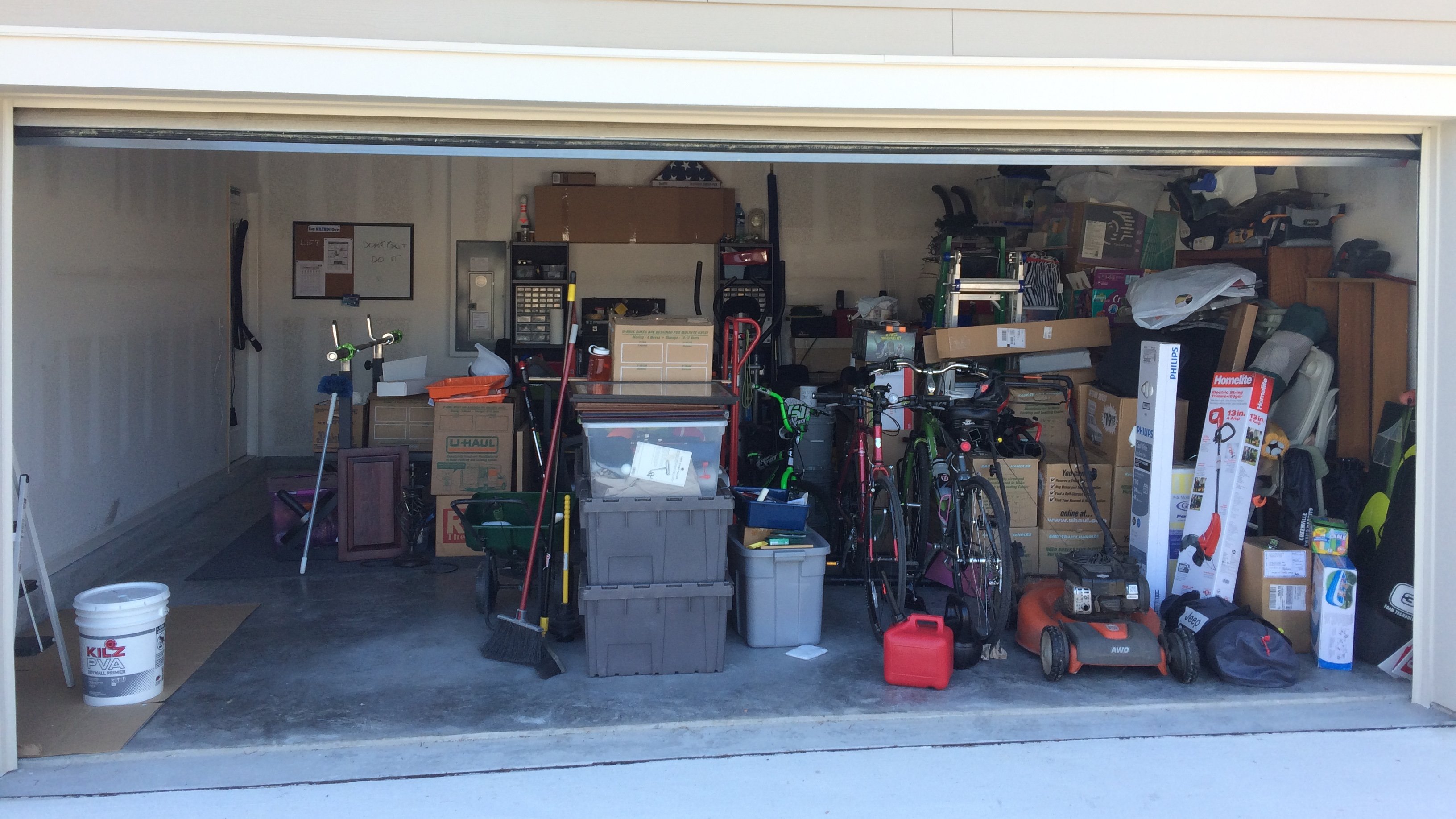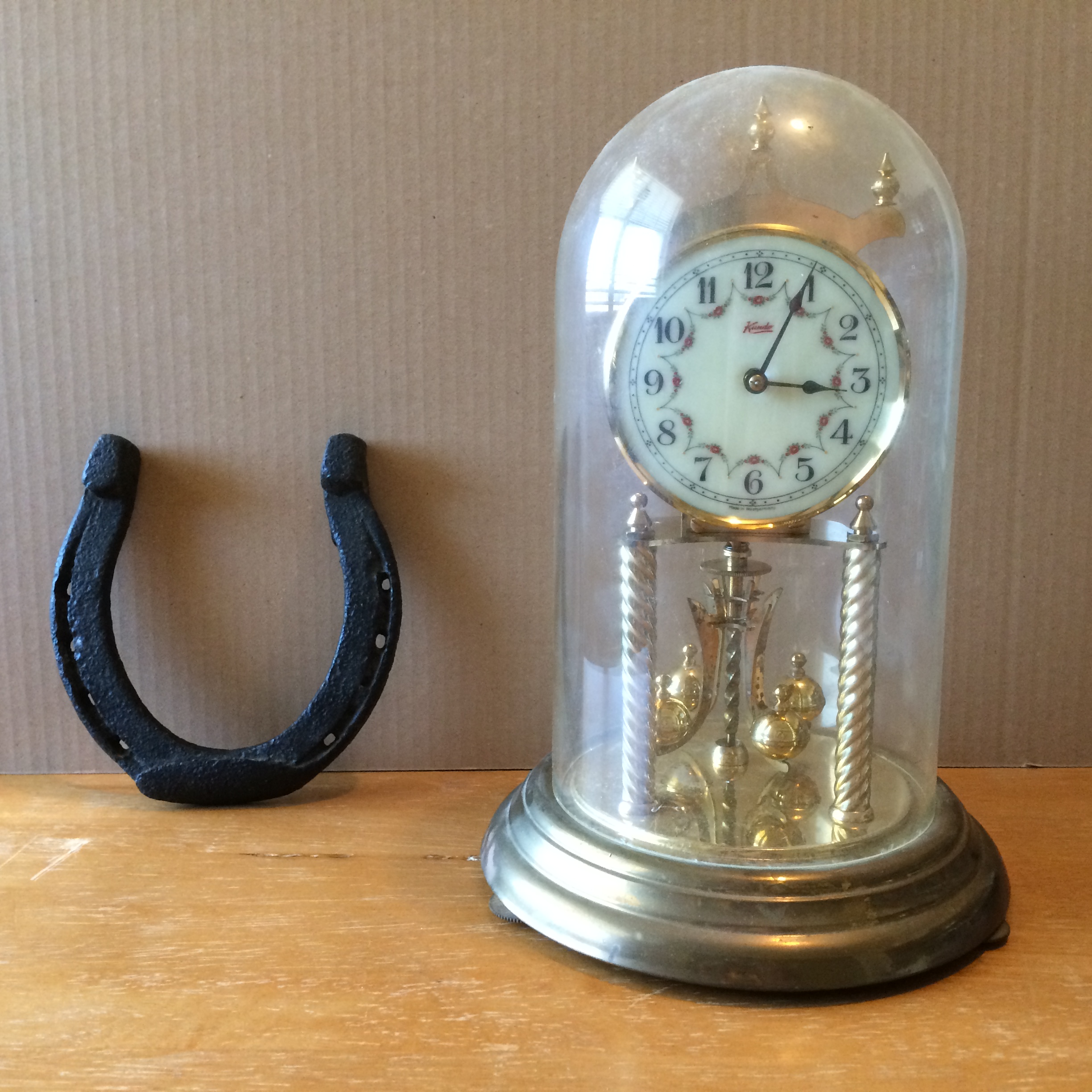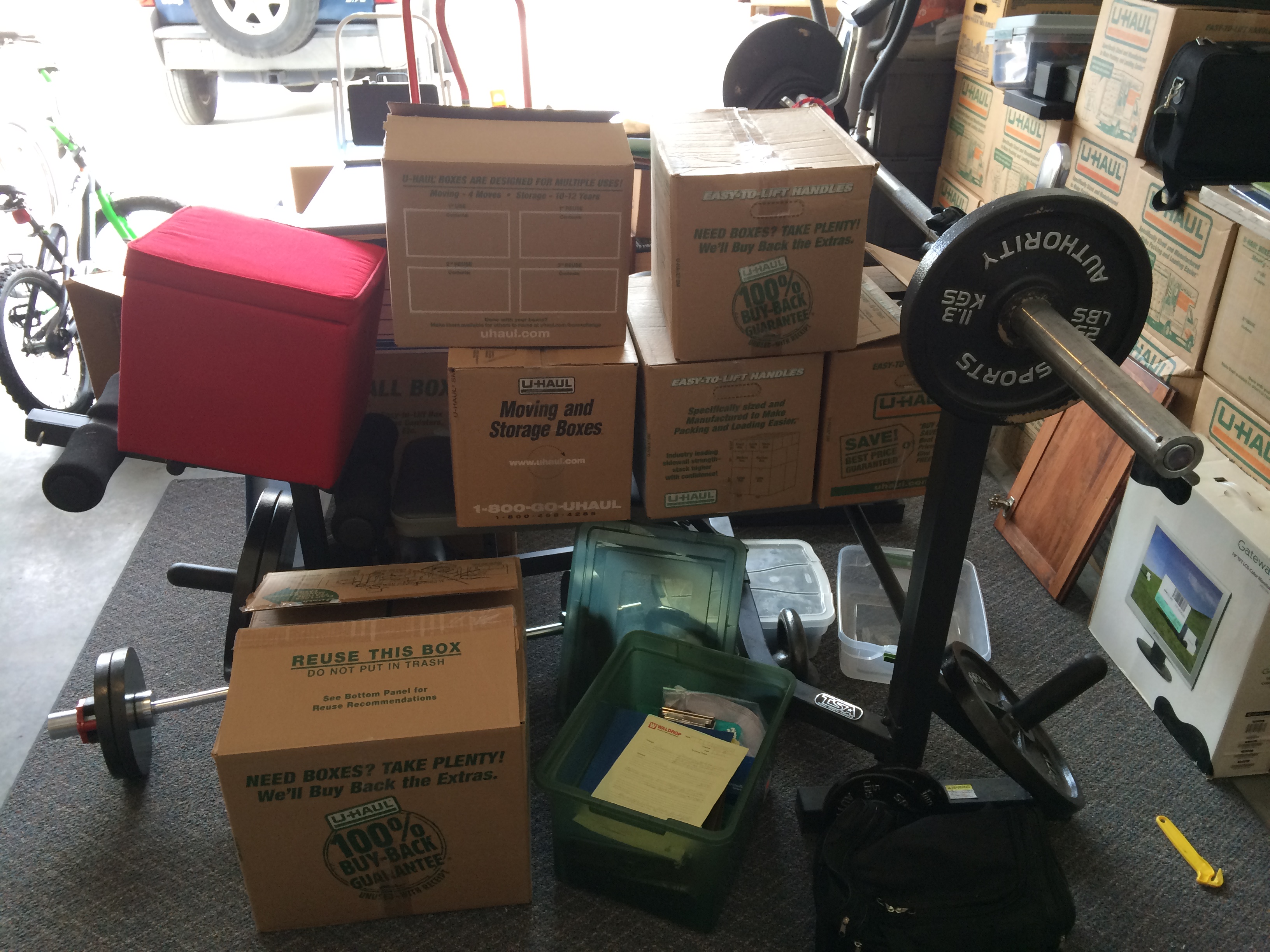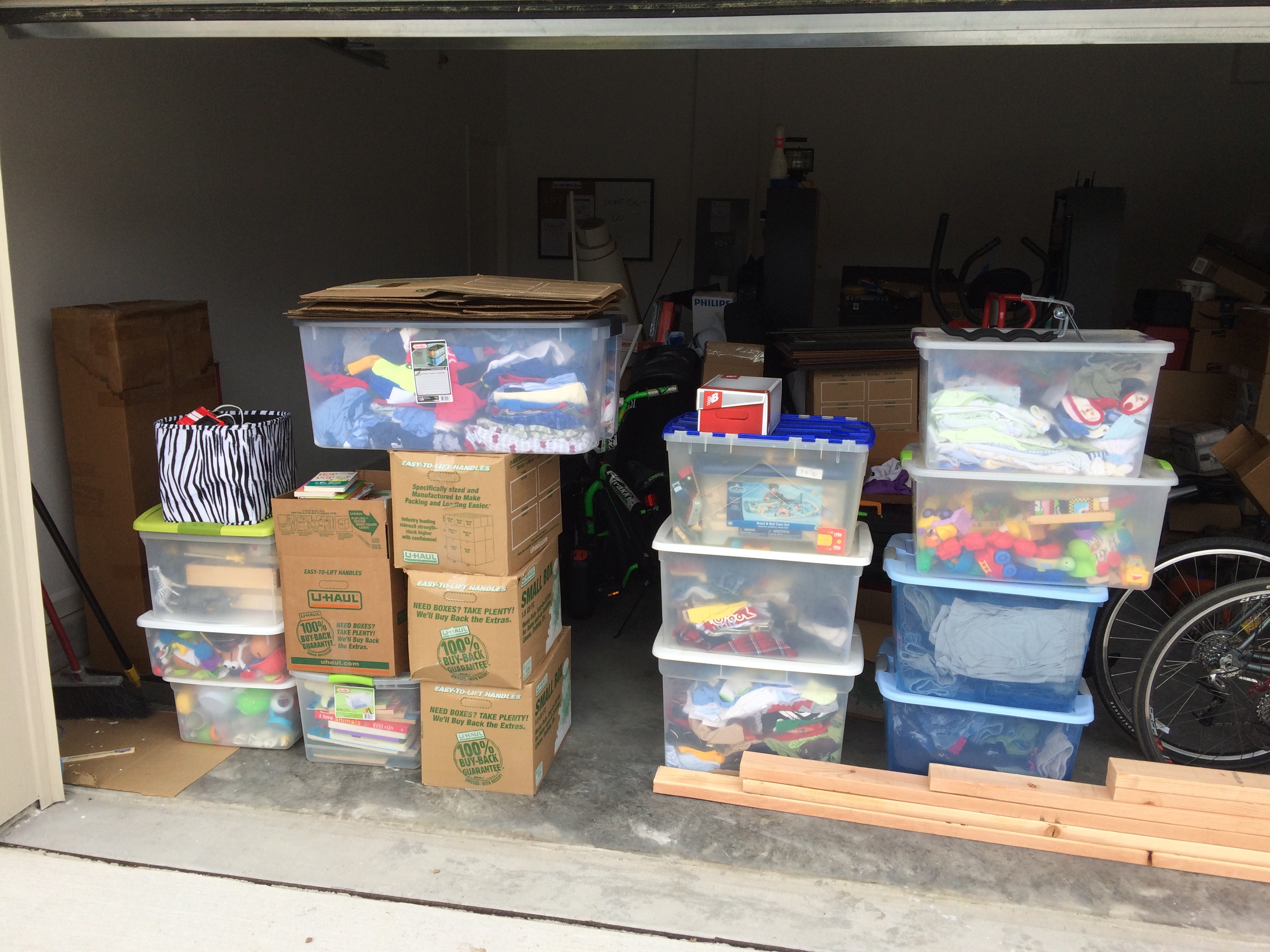Unless you have a gym membership (and even if you do) once you get serious about fitness, you will find the urge to have an area dedicated for fitness, even if it’s only a small corner of your home. Some people are lucky enough to have a spare room well suited to becoming a home gym, but most of us make due by dedicating a portion of their basement or garage. The Kilted Dad is one of the latter, converting a portion of the family garage for the Kilted Gym. Unfortunately, a weight bench, like any other flat surface in the home, can easily become buried under clutter if neglected for too long.
In fact, that’s why I haven’t posted as much over the past week. I’ve spent most of my spare time engaged in a minor renovation and reorganization of the garage to create a dedicated fitness space – henceforth to be known as The Kilted Gym. But if you’ve ever tried anything similar, you know that no project is ever as simple as you initially intended it to be and any one project usually blossoms into a series of interdependent projects. Such was the fate in store for our family garage which couldn’t be a simple cleanup and reorganization job.
You see, every step of the project was slowed because of how much stuff we have in the garage. How much stuff, you might ask? Too much. So, what is our fascination with stuff and how does it get in our way? The best take I have ever heard on the concept is George Carlin’s description of Stuff.
The American Garage
Almost every home in America has a garage, usually with 2 and sometimes three stalls for parking cars. But how many of us actually use our garage for its intended purpose? A 2015 survey by Gladiator Garage Works (the people who make the very nice but also very expensive garage storage solutions available at Lowe’s) say that one in four Americans say their garage is too cluttered to fit a car. I’m not so sure I believe their numbers, because in a less official poll I have observed that approximately 80% of the homes in my neighborhood have 2 or more cars parked in the driveway or on the street.
In my 14 years of home ownership, I have probably only parked in the garage a handful of times, and in three of those cases we only squeezed the vehicles in because of an approaching hurricane.
The garage typically serves as a convenient storage room for several reasons. The garage is usually the largest contiguous space available in most homes (at least those without an unfinished basement). Garages are also big enough that they can hold a lot of extra stuff in a more spread out and accessible manner than jamming things into a closet. The garage offers a transitional space between the “outdoors” and the “indoors” making it ideal for sporting goods, gardening supplies, tools and paints, and other dirty, messy, or smelly stuff. Finally, if you’re not using it for parking, a garage offers a great sense of “out of sight, out of mind” for the stuff you don’t need to or want to deal with on a daily, weekly, or even monthly basis.
Our Garage Was No Different
As I may have mentioned in an earlier post, our family has recently moved into a new house in a new city. Before moving in we had decided that we wanted to take a minimalist approach in the new house, so we had a successful garage sale, which helped us get rid of a bunch of random stuff and furniture we didn’t want to move. The we donated a bunch of old clothing to Goodwill and The Salvation Army – my old suits and sport coats, my wife’s “teacher outfits,” and a lot of the kid’s clothes that didn’t sell in the sale – 10 garbage bags full in total.
Despite the first round of downsizing, we still ended up moving more stuff than we realized that we owned to our new home. Our old house had two nice attic storage areas, where we stashed tons of baby stuff after moving in. Although our new house is a little bigger, it does not have any hidden storage areas – so everything that isn’t “on display” must fit into the closets or the garage.
We moved eight storage tubs of full of nearly-new clothing which we had outgrown as we put on weight – but which we have kept in hopes of losing that weight. We had twelve tubs full of holiday decorations for Christmas, Halloween, and the rest. I still had sixteen boxes of Star Wars collectibles (after selling eight boxes before the move!). And then there were the books. All three of us in the family are avid readers and collectors of books. We moved over 40 boxes worth of books and probably another 10 of paperwork to the new house, most of which doesn’t fit into the minimalist plans. Furthermore, we sold, donated, or destroyed more than half of our book shelves before the move and my wife does not want shelves packed with books all over our house.

The picture above shows some of the disorganized mess that was our garage. At this point we had already sorted through about 20 boxes of books and 6 tubs of clothing to clear the path down the left side of the garage and start painting.
When we moved, everything except the furniture, clothing, major electronics, and the kitchen went into the garage. Our intent was that everything would stay there unless or until we decided that we needed it in the house. Almost every box was properly labelled so that we could easily retrieve it when the need arose. Then, and only then, would we find that item a new home inside the house.
For the first 3 months, that plan worked well for us. It also helped us realize just how much stuff we really have. After 3 months, 2/3 of our garage was still packed with boxes and tubs in stacks up to 8’ high. The rest of the space was taken up by our bikes, weight bench, and tools.
When the decision was made to start the Kilted Dad the need for a more dedicated gym space took precedence over any other plans for the garage and our stuff. We came up with a plan that involved, decluttering, organizing, and painting the garage so we could customize the gym space (not necessarily in that order). We started with the painting, but I would recommend decluttering be the first step.
Decluttering your Space
There are articles, blogs, television shows, and even full-time careers dedicated to decluttering. I don’t know if I can offer any new insight on the subject, but I see several different ways you should attack the process. Wherever you start, remember this adage from the Boy Scout Handbook about how to eat an elephant – you eat an elephant one bite at a time.
It doesn’t matter whether it is your living space or your storage space, you should attack decluttering one bite at a time. Begin with your living space. Start with one shelf drawer, or surface, then clean another, then another, until you have completed one room. Then move to the next room and so on. Once you have cleaned, cleared, and decluttered your living space, it’s time to move on to your storage spaces. Follow the same procedure, going through one box at a time or one tub at a time. Through this process, you may move items from your living space into storage, and vice versa.
As you sort through your possessions, you should classify your stuff as Keep, Store, or Get Rid Of. Keep the stuff you know you use regularly or know that you’ll need. Store the stuff that you know or think you’ll need eventually, but just not in the immediate future. Everything that’s left, is possibly something you need to Get Rid Of (more on this later).
But decluttering is often easier said than done. You may be making great progress, plowing through box after box sorting them into a new storage space, a donate pile, or into the trash. Undoubtedly, you will eventually run into something that will stop you. It may be that you have been working for too long, or maybe a box of stuff you’ve been putting aside for years, or like what stopped me, a box of my dad’s stuff that I just didn’t want to think about or deal with.
If you find yourself struggling over a box or an item, just start asking yourself these questions – the answers will help you make your decision.
Do I use this? – If this is an item that you are actively or regularly using, you can feel confident keeping it. How regularly you use it may determine whether you keep it out on a desktop, a shelf, or in a drawer. If you don’t anticipate using it regularly, you should probably store it somewhere or get rid of it.
When was the last time I used this? – If it’s been more than six months or a year, you may not need it anymore and should consider getting rid of it. There are of course exceptions and you can deal with exceptions with the next question.
When will I need to use this next or again? – Some items are seasonal, like holiday decorations. It’s OK to keep seasonal items, but find a remote storage location for them like your attic, basement, garage, or a “holiday closet.” If you don’t have a definite answer, it may be time to let it go. There are, however, guidelines on how long to keep certain documents such as financial guru Dave Ramsey’s Organizing Your Important Documents.
Do I “have plans” for this item? – You may be keeping items because you have a future project in mind. That’s fine, but you need to create a deadline to finish that project. If you haven’t finished it by then, let it go.
Is it broken? Can I fix it? Is it worth fixing? – Gone are the days of the local electronics repair shop, TV repair shops, and vacuum cleaner repairs. If you were to compare the cost of new items to repairs today, most items just aren’t worth repairing anymore. Still, we will often keep broken items with the hope of fixing them ourselves, or the newer trend of “repurposing” them (many such suggestions are ridiculous such as 10 ways to repurpose a knife block – 4 of them repurpose an old knife block into a decorated knife block!). Consider this “having plans” for the broken item, set a deadline, and throw it out if you haven’t used it by the deadline.
Is it an heirloom? – Sometimes it’s hard to get rid of the things we consider to be family heirlooms, or hope to pass down as an heirloom. When making these decisions, which can be the toughest, consider the sentimentality of the item, the stories attached to it, its continued usefulness, or in some cases its longevity. On one hand, I think of Butch’s watch from Pulp Fiction which had been passed through several generations of the family and the efforts Butch’s had gone through to get it to him. On the other hand, there’s my baby crib that my mom wanted to be sure that I got before we had my son, but which does not meet modern safety regulations and isn’t all that stable – I still have it, but do I really need to keep it packed in a box never to be used again? If it is an heirloom that you will be keeping but not using, ensure that it is properly packed for long term storage so that it can be passed down.
 Heirlooms can be the toughest decisions you’ll make. Take for example two items from my grandparents. On the one hand, I have an ornate looking anniversary clock that was given to me after my dad’s passing. It’s nice enough, and I always remember it from trips to their house, but it’s been stored in the garage for over 15 years and because of that hasn’t been maintained. Furthermore, my wife doesn’t like it. On the other hand, there’s an old horseshoe that my grandpa always had nailed up in his garage or over the workbench. After his passing, my dad did the same with it. Although I’m probably above average in the area, they were both much more mechanically inclined and their workshops were their relaxing retreat. Not so for me. So, what should I do with these items? (Stay tuned for answers…)
Heirlooms can be the toughest decisions you’ll make. Take for example two items from my grandparents. On the one hand, I have an ornate looking anniversary clock that was given to me after my dad’s passing. It’s nice enough, and I always remember it from trips to their house, but it’s been stored in the garage for over 15 years and because of that hasn’t been maintained. Furthermore, my wife doesn’t like it. On the other hand, there’s an old horseshoe that my grandpa always had nailed up in his garage or over the workbench. After his passing, my dad did the same with it. Although I’m probably above average in the area, they were both much more mechanically inclined and their workshops were their relaxing retreat. Not so for me. So, what should I do with these items? (Stay tuned for answers…)
Are the items adding value to your life? – Consider that heirloom that is currently in storage. Is that the best place for it? Consider passing it down now so it can be enjoyed by those whom you intend to receive it (or so they can store it with their stuff). Or maybe consider whether it might be more useful for someone else. Most of the women in my family have had a lot of jewelry in their lives and would want to pass it down to me for my wife. But my wife doesn’t wear jewelry and likely won’t start so the question for my mom now is will she be happier for us to save it for a future daughter-in-law or possibly sell it, or should she give it to another female relative who might use it?
After having sorted through the first round of our stuff, we feel we’ve made great progress. Below are 12 tubs of clothing and baby items plus 4 boxes of books we sorted into our Get Rid Of piles (this was our second Get Rid Of pile).
Decluttered Yet?
Are you living the decluttered life in the perfect minimalist utopia? Probably not. I know we still have a long way to go in this endeavor, but the progress became totally evident to me last night after I finished a storage rack and a tool bench and packed up a huge batch of our Get Rid Of stuff. The saga continues in the next post with details on Getting Rid of Stuff and Getting Organized.

